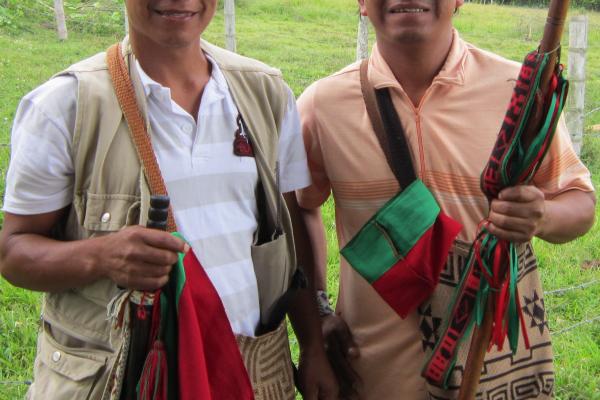Activists from Colombia’s indigenous Nasa people continue to make headlines — but there’s far more to their peacemaking than the occasional story that makes the U.S. news. Here’s part II of the interview I did with two Nasa Indigenous Guard members, Manuel and Herman, in Cauca, Colombia, last August. The interview took place a month after an earlier round of violence: a bus bomb, suspected to be from the FARC, that went off in the town of Toribío, killing three and wounding more than a hundred in July 2012.
Sojourners: What’s it like to be in the Indigenous Guard?
German: Being an Indigenous Guard is very risky. Obviously there are moments of conflict in which you know what you’re facing -- then there are moments of apparent calm, but calm can switch into situations of risk very quickly.
Sojourners: What strategies do you use in walking up to an armed group?
German: In the case of a gunfight on our lands, if the fighting is very intense, the first thing we try to do is make sure that none of our community members are caught in the crossfire. When we need to rescue a family, we go in with a bunch of flags on poles, high enough that the armed actors can see them. Sometimes we use blue and white flags, and other times we use the flag of CRIC, our indigenous organization, so that they know who it is that’s going in there.
We’ve set up shelters where, if the fighting is very intense, we call in the entire community to come together in that space—someone’s house, a health center, a community center. We bring everyone together, not just to be in hiding, but also to reflect on what’s happening, to talk about it, and to strengthen ourselves. We’re working very hard to make sure that people don’t feel like they have to flee, because we do not want to abandon our land.
Jess Hunter-Bowman [the Witness for Peace associate director who translated the interview]: They’re using the indigenous word for Indigenous Guard, and I want to get that down for you: Kiwe Thegnas. The way that they’re translating that is, “the guide of the Nasa people when dealing with an emergency.” But you can also translate it “Indigenous Guard.”
Sojourners: What was the response of the Indigenous Guard and Nasa people generally to the bus bomb that went off in Toribío?
Manuel: That hurt the indigenous communities deeply; Toribío [is] a Nasa indigenous town. Toribío has been the heart and the birthplace of this [unarmed indigenous] resistance movement.
The Indigenous Guard from across northern Cauca went to Toribío, to be with these people who were so tired of all the damage and destruction of the war there. We spent two days there in meetings to discuss what we were going to do about this and what we decided was that we were going to declare Toribío and all the municipalities of northern Cauca territories of peace.
German: When we gathered together on July 20 in Toribío in response to this attack, there were 5,000 of us that were there and people all over the province of Cauca, of the 116 different indigenous communities that make up the Regional Indigenous Council of Cauca (CRIC).
And during those two days with 5,000 people we reflected a great deal on how are we going to survive on these lands when faced with such a terrible conflict. We do not want to abandon our lands, and so we had to look at a number of different strategies that we could use in order to be able to stay.
And so out of this meeting that we had with the 5,000 people in Toribío, we came out with a statement demanding that our rights as indigenous communities be respected, that armed actors need to respect the rights and lives of civilians, and also that our territory and our lands be respected.
Elizabeth Palmberg is an associate editor of Sojourners. She wrote about her trip to Colombia in Standing Up to Death Squads, and tweets @ZabPalmberg.
Got something to say about what you're reading? We value your feedback!
